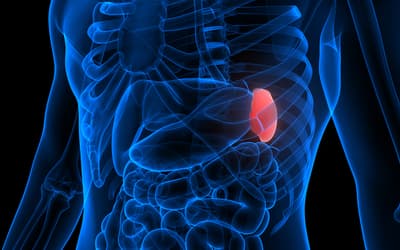The views expressed in this paper are those of the writer(s) and are not necessarily those of the ARJ Editor or Answers in Genesis.
Abstract
This paper evaluates the evidence for the evolution of animal food intake systems. The simplest system is endocytosis and the next complex system is swallowing food whole. Lastly is the most complex system that involved chewing food to break it up into smaller, more easily swallowed, pieces. No fossil or other evidence of this critical evolutionary progression claim has been documented in the relevant literature. Nor have plausible just-so stories have been presented to outline probable evolutionary steps. The most reasonable scenario, given the extant evidence, is ex-nihilo (creation from nothing) creation.
Keywords: human anatomy and physiology, evolution of body organs, animal oral cavity, endocytosis, food intake systems, teeth
Introduction
All animal life requires taking in the nutrients found in solid food and liquids. Only two known methods exist to achieve this life sustaining requirement. The first way is endocytosis and diffusion which are typical of one-celled animals. Endocytosis is a general term which involves taking in substances from outside of the cell by engulfing it in a vesicle made of the cell’s membrane, as shown in fig. 1. The process is subdivided into phagocytosis (cell eating) and pinocytosis (cell drinking). A second method uses a mouth, in humans an opening in the face surrounded by lips, through which food is taken in. The “mouth is present in all animals and comprises an opening from the outside into the oral cavity and the beginnings of the digestive tract to allow eating” (Chen et al. 2017).

Fig. 1. The three types of endocytosis. https://commons.wikimedia.org/wiki/File:0309_Three_Forms_of_Endocytosis.jpg.
The evolution of the mouth has baffled Darwinists. Its evolution is considered so unlikely that evolutionists “conclude that the mouth arose [only] once during evolution” (Chen et al. 2017). Evidence for the “single origin of the mouth is a conserved set of genes that form a ‘mouth gene program’ including foxA and otx2” genes (Chen et al. 2017). Other evidence includes the fact that the mouth of all known animals is constructed from the combined ectodermal and endodermal germ embryo layers.
According to Darwinists, the first multicellular animals with a defined mouth were diploblasts. Diploblasts include Cnidaria (anemones, corals, jellyfish) and ctenophores (comb jellies). The 11,000-plus species in the Cnidaria phylum are radially symmetrical, aquatic, invertebrate animals that have a hollow digestive cavity (see fig. 2).

Fig. 2. Sea anemone. https://commons.wikimedia.org/wiki/File:Sea_Anemone_%2810062178943%29.jpg.
Mouth food-intake systems involve two methods: (1) swallowing prey whole, such as used by snakes, crocodiles, alligators, and most birds, and (2) chewing the food, used by most mammals. One exception is mammals that live off of small insects, such as anteaters. If the prey is very large, some animals can break it up, such as sharks biting chunks of their prey to enable them to consume it. Although “almost all snakes swallow their prey whole,” two “species of Asian crab-eating snakes tear off crab legs and ingest them one at a time to eat prey that is otherwise too large” (Mizuno and Kojima 2015).
Some birds use their pointed beaks to pull large living prey apart, but usually swallow the sections whole. In this system, gravity does much of the work getting the food into the stomach. Snake “teeth” are designed mostly to prevent the prey from escaping until it can be swallowed whole. Lastly, the norm for most all mammals is chewing, referring to using teeth to mechanically break down food into pieces, or even purée, that can be swallowed, digested, and absorbed.
No animal can survive until its entire ingestion system from mouth to anus is fully functional and operational (Hofman 1989). The irreducibly complex system described above presents an insurmountable problem for evolution. Even the proposed just-so theories attempting to explain this problem have eluded Darwinists.
Reptile Eating
Teeth are the heart of chewing food. Except for turtles, all reptiles, including snakes, lizards, crocodilians, and tuataras, possess teeth (Wyneken and Mader 2002). Non-cutting teeth are frequently angled backward to prevent the prey from escaping (Tennant 2003). Reptile teeth are bonded onto the jawbone itself (acrodont teeth), and, except for the crocodilians, are not attached in sockets extending deep into the jaw (thecodont teeth) as is the case for most mammals (Pettit 2019). Furthermore, the teeth of “reptiles are generally homodont (all teeth have a similar shape) whereas mammals have heterodont dentition (differently-shaped teeth that belong to several tooth classes: incisors, canines, premolars, and molars)” (Juuri et al. 2013, 1424).
Although reptilian teeth are viewed by evolutionists as primitive, in one way they are more advanced than mammalian teeth. Specifically, the majority of vertebrates, including fish, sharks, amphibians, and reptiles are able to renew their dentition multiple times throughout their lifespan (polyphyodonty). In contrast, most mammals can replace their teeth only once in their life—when their baby teeth are replaced by their adult teeth (diphyodonty) (Jernvall and Thesleff 2012).
The jaw design is another example of a major difference between reptiles and mammals. Snake jaws are not fused at the jaw joint as is the design employed in mammals. Rather, unlike the mammalian jaw, a snake’s jaw is “rigged with tendons, muscles, and ligaments that give the jaw a gymnast’s flexibility” (Binns 2012). In addition, the skin around the reptilian mouth and throat is pliable and can be comfortably stretched, allowing this jaw design to function without tearing the skin.
To prevent choking on their prey, snakes have a built-in cartilaginous breathing tube called the glottis which the snake can extend forward and out the side of their mouth to prevent this life-ending choking problem. Once the prey is firmly in its grasp, the snake has no choice but to finish its meal. The small animal they swallow cannot normally work its way out of the snake’s body. In contrast to a snake’s small and weak tongue, mammals use a strong muscular tongue to help force food down the throat.
Snakes normally swallow their prey whole; therefore, they must digest the entire animal, fur, and all. Depending on the size of the snake and their prey, it may require from three days to as long as a month to digest its prey. During this time of digestion, as those who have snakes as pets know, they usually require rest and quiet. Even gently handling them may cause the snake to vomit up its prey.
Mammal Masticatory System
Chewing and swallowing are everyday activities taken for granted by most humans until problems develop. The over 100 structures, including nerves, arteries, capillaries, and tissues involved will only briefly be described here. This complex process involves mechanical grinding of food into small or microscopic pieces in the oral cavity. The system breaks down food into small chunks or slurries to enable it to travel through the esophagus into the stomach. Chewing also increases the food’s surface area to allow digestive enzymes to effectively further break it down. Many different structures, including teeth, mandible (jawbone), tongue, and eight muscles must all harmoniously work together with the nervous system and brain to achieve mastication.
The muscles involved include the masseter, temporalis, medial pterygoid, and lateral pterygoid. The left and right powerful masseter jaw muscles, one on each side of the face, raise the lower jaw during chewing to crush the food. Herbivorous animals have large, very strong masseter muscles to break down plant materials, which require a lot of grinding.
All mammals have very similar masticatory systems which are markedly different from those used to eat by reptiles. The mammalian oral cavity includes three main exocrine salivary glands including the parotid, submandibular, and sublingual glands. The accessory salivary glands are the mucus-producing cells located in lingual, palatine, and buccal areas. The “energetic efficiency of masticatory effort is fundamental in understanding the evolution of the human masticatory system” (van Casteren et al. 2022).
The Next Step Is Swallowing
The process of swallowing (called deglutition) involves the movement of food from the oral cavity into the stomach via the pharynx and esophagus. The “reflexive and voluntary actions of over 30 nerves and muscles produce this coordinated movement” are required to move the food into the stomach (Panara, Ahangar, and Padalia 2021). The tongue muscle contracts superiorly to elevate and force the food bolus posteriorly into the first part of the pharynx called the oropharynx (Matsuo and Palmer 2008).
When swallowed, mixing and maceration by stomach muscles and hydrochloric acid secretions, breaks down food into chyme (Anonymous 2019). Chyme increases the surface area of food to allow the digestive enzymes to chemically break the large molecules into smaller molecules. Chyme also stimulates various digestive glands to release their secretions. To function, enzymes require direct contact with the food molecules. For this reason, the mastication process, as described above, is required for mammals and certain other animal groups to survive. Furthermore, mammals could not survive until all of the parts described above existed and were all functionally integrated as a functional working system. This fact has proven to be an overwhelming problem for evolution. The gastrointestinal tract that begins with the mouth then the pharynx (throat), follows with the esophagus, stomach, small intestine, large intestine, cecum, rectum, and anus) must be functionally matched with the system described above.
The Evolution of the Mastication System
In the “1940s, and only after a number of alternatives were suggested, Darwinists succeeded to establish natural selection and gene mutation as the main evolutionary mechanisms” that were driving evolution (Armon 2010, 173). In short, evolution from molecules to humans “results from natural selection among organisms, which acquire beneficial mutations through random mutations” (Armon 2010, 173). The theoretical evolution of the masticatory system described above is built on a paucity of evidence.
How mammals consumed solid food before mammals had teeth, jaws, jaw muscles, and the nervous system that functioned as a unit to chew food is a major concern for evolution. The mammal teeth themselves are very complex (figs. 3 and 4). Snakes swallow their prey whole, but still must digest it, requiring the digestive enzymes that can break down an entire animal as described above. Mammals must also chew their food before swallowing and digesting it, which requires even more complexity in a system that necessitates all of the parts to accomplish this task.

Fig. 3. The four types of human teeth. Note that both those teeth used for carnivores and herbivores are included. This diagram correctly included wisdom teeth (or third molars), which are not vestigial. https://commons.wikimedia.org/w/index.php?curid=54970435. Also see: https://en.wikipedia.org/wiki/Human_tooth#/media/File:3D_Medical_Animation_Still_Showing_Types_of_Teeth.jpg. http://www.scientificanimations.com. CC BY-SA 4.0.

Fig. 4. Diagram of a tooth showing that they are not simple but very complex structures. KDS4444. https://en.wikipedia.org/wiki/Human_tooth#/media/File:Human_tooth_diagram-en.svg. CC BY-SA 4.0.
Since creation is a priori ruled out by evolutionists, the only alternative remaining to explain the origin of mastication is evolution. Consequently, researchers must assume that this complex mechanism originally existed as a functional unit which evolution cannot explain. Evolutionists have no plausible idea how it evolved but assume the system existed but once it exists can be fine-tuned by evolution: “We assume that natural selection produced jaws, facial muscles, and teeth that make the chewing system as efficient as possible, thus minimizing the energy spent chewing food . . .We therefore think that how we humans chew today has been optimized by evolution” (Leiden University 2022). Furthermore
Modern humans . . . don’t chew very much because we cook and process all of our foods before we eat. But our ancestors would have been spending a lot of time chewing. . . . our early hominid ancestors may have been chewing for five or six hours a day . . . which may have cost them up to 5 percent of the energy they consumed. It’s possible that this drove the evolution of the form or muscle architecture of the jaw, or changes in tooth morphology. (Mesa 2022, 2)
Fire used for cooking has liberated humans from lengthy bouts of daily mastication. In comparison, the great apes chew for considerably longer times than humans, ranging from 4.5 hours in chimpanzees to 6.6 hours in orangutans. Thus, evolutionists reason, the discovery of fire allowed humans to cook their food and spend far less time chewing and more time developing tools which resulted in brain development.
Evolutionists claim that our ape ‘brothers’ did not develop the use of fire and were forced to continue to spend most of their day chewing. Thus remained apes, where we evolved into naked apes, modern humans. One implication from evolution is that if orangutans had discovered fire, modern humans may have descended from them instead of some chimp ancestor, and modern humans would look and act very differently! The problem with this story is it supports the ex nihilo creation position because the evidence supports the use of fire very early after modern humans were created.
Summary
Our literature review found no specific and clearly stated evidence for the evolution of the mouth, chewing, or any other part of the gastrointestinal tract system. Even plausible just-so stories are non-existent. The lack of evidence for any gastrointestinal tract evolution has led to the conclusion that “the mouth arose once during evolution and that fundamental aspects of a mouth program have been retained amongst all animals” (Chen et al. 2017, 7). Articles such as “Evolution of gastrointestinal tract morphology” simply note differences in gastrointestinal tract structures and conclude that evolution was responsible for the differences (Riddle et al. 2019). Aside from noting that structure B is slightly more complex than structure A, and therefore structure B could have evolved from structure A, no evidences for evolution of structure B from structure A was claimed (Riddle et al. 2019).
A lack of evidence for the evolution of the mouth, swallowing, and associated structures is not unexpected. The late Harvard professor Ernst Mayr wrote: “one would expect the fossils to document a gradual steady change from ancestral forms to the descendants. But this is not what the paleontologist finds. Instead, he or she finds gaps in just about every phyletic series. New types often appear quite suddenly, and their immediate ancestors are absent in the earlier geological strata . . . the fossil record is one of discontinuities, seemingly documenting jumps (saltations) from one type of organism to a different type” (Mayr 2001, 14). This observation conforms to, and confirms that, the above brief review of the evolution of the mouth, swallowing, and associated structures is false. The system must have been created ex nihilo.
References
Anonymous. “Mastication.” 2019. Biology Dictionary, October 4. https://biologydictionary.net/mastication/.
Armon, Rony. 2010. “Beyond Darwinism’s Eclipse: Functional Evolution, Biochemical Recapitulation and Spencerian Emergence in the 1920s and 1930s.” Journal for General Philosophy of Science 41, no. 1 (27 June): 173–194.
Binns, Corey. 2012. “How Do Snakes Swallow Large Animals?” Live Science (September 12). https://www.livescience.com/32096-how-do-snakes-swallow-large-animals.html.
Chen, Justin, Laura A. Jacox, Francesca Saldanha, and Hazel Sive. 2017. “Mouth Development.” Wiley Interdisciplinary Reviews: Developmental Biology 6, no. 5 (September/October): e275. doi: 10.1002/wdev.275.
Hofman, R.R. 1989. “Evolutionary Steps of Ecophysiological Adaptation and Diversification of Ruminants: A Comparative View of Their Digestive System.” Oecologia 78, no. 4 (March): 443–457.
Jernvall, Jukka, and Irma Thesleff. 2012. “Tooth Shape Formation and Tooth Renewal: Evolving With the Same Signals.” Development 139, no. 19 (October): 3487–3497.
Juuri, Emma, Maria Jussila, Kerstin Seidel, Scott Holmes, Ping Wu, Joy Richman, Kristiina Heikinheimo, et al. 2013. “Sox2 Marks Epithelial Competence to Generate Teeth in Mammals and Reptiles.” Development 140, no. 7 (April): 1424–1432.
Leiden University. 2022. “Hard chews: Why mastication played a crucial role in evolution.” Physics Organization (August 17). https://phys.org/news/2022-08-hard-mastication-crucial-role-evolution.html/
Matsuo, Koichiro, and Jeffrey B. Palmer. 2008. “Anatomy and Physiology of Feeding and Swallowing: Normal and Abnormal.” Physical Medicine Rehabilitation Clinics of North America 19, no. 4 (November): 691–707.
Mayr, Ernst. 2001. What Evolution Is. New York, New York: Basic Books.
Mesa, Natalia. 2022. “The Energetic Cost of Chewing May Have Shaped Hominin Evolution.” The Scientist. https://www.the-scientist.com/news-opinion/the-energetic-cost-of-chewing-may-have-shaped-hominin-evolution-70382.
Mizuno, T., and Y. Kojima. 2015. “A Blind Snake That Decapitates its Termite Prey.” Journal of Zoology 297, no. 3 (November): 220–224.
Panara, Kush, Edris Ramezanpour Ahangar, and Devang Padalia. 2021. “Physiology, Swallowing.” National Center for Biotechnology Information. National Library of Medicine (July). https://www.ncbi.nlm.nih.gov/books/NBK541071/.
Pettit, Rebekah. 2019. “Reptile Dentition: The Details on Reptile Teeth.” Reptiles (May 8). https://reptilesmagazine.com/reptile-dentition-the-details-on-reptile-teeth/.
Riddle, Misty R., Fleur Damen, Ariel Aspiras, Julius A. Tabin, Suzanne McGaugh, and Clifford J. Tabin. 2019. “Evolution of Gastrointestinal Tract Morphology and Plasticity in Cave-Adapted Mexican Tetra, Astyanax mexicanus.” bioRxiv (November). https://www.biorxiv.org/content/10.1101/852814v3.
Tennant, Alan. 2003. Snakes of North America: Eastern and Central Regions. Dallas, Texas: Taylor Trade Publishing.
van Casteren, Adam, Jonathan R. Codd, Kornelius Kupczik, Guy Plasqui, William I. Sellers, and Amanda G. Henry. 2022. “The cost of chewing: The energetics and evolutionary significance of mastication in humans.” Science Advances 8, no. 33 (August). https://www.science.org/doi/10.1126/sciadv.abn8351.
Wyneken, Jeannette, and Douglas Mader. 2002. “The Oral Cavity of Reptiles—Anatomy, Physiology, and Clinical Perspectives.” Proceedings of the Association of Reptile and Amphibian Veterinarians, 177–181.



